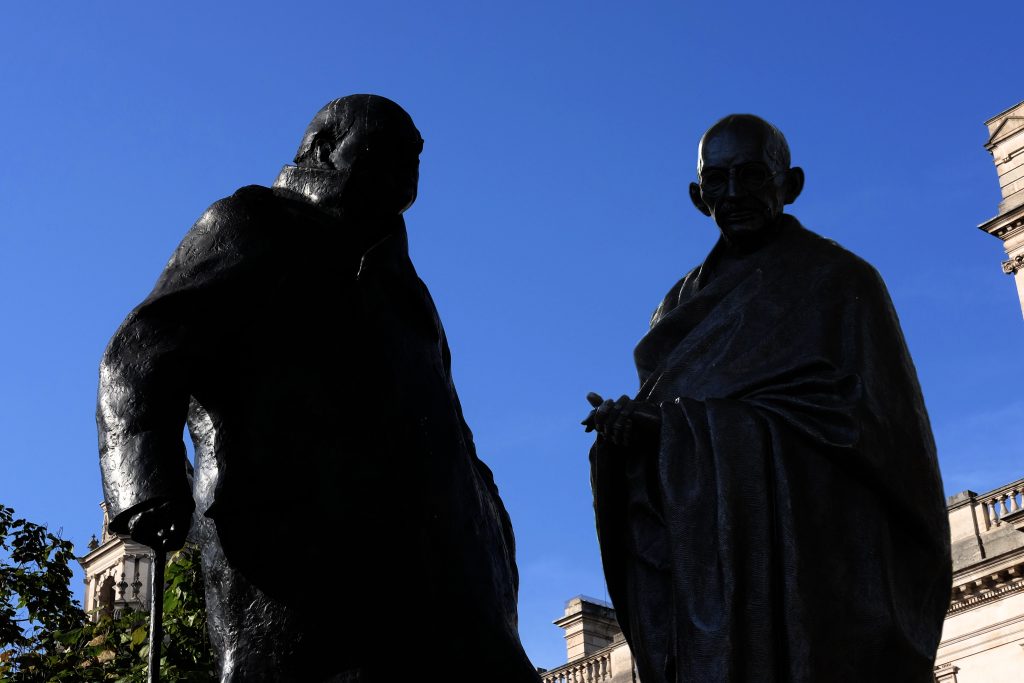By Samantha Lo
When you visit Parliament Square, take a moment to marvel at the grand statues surrounding the greenery and you will discover something quite bizarre. The statue of Mahatma Gandhi, the famous leader of the Indian independence movement, is erected just a short walk away from the statue of his age-old political enemy, Winston Churchill. The blatant irony here prompted me to reflect on the nature and function of statues – they are associated with prestige and honour, conveying the message that the person depicted ought to be remembered and looked up upon (quite literally). If Gandhi is placed in Parliament Square to celebrate his victory for Indian independence, isn’t it problematic that Churchill’s statue stands alongside him as one of India’s colonisers? Perhaps the irony is precisely the point – the statues silently invite us to confront history as it happened.
Around London, the former capital of the British Empire and historical centre of the Atlantic slave trade, many statues of figures involved in the colonial project are erected to commemorate what were once regarded as their “achievements”. The statue of Robert Clive, for example, proudly stands in King Charles Street, Whitehall. Clive was the first British Governor of the Bengal Presidency and a significant figure in laying the foundation of the East India Company. Venerated in the 19th century for his military service and acquisition of wealth for the British Empire, Clive is now unable to escape criticism for his ill treatment of his colonial constituents, being labelled a “vicious asset-stripper” by historian William Dalrymple. What message is Britain sending by failing to tear down these many statues of colonial officials? By living in the city today and not actively opposing the existence of such monuments, are we also guilty of pushing a long-outdated colonial narrative?
With the Black Lives Matter movement raising public awareness of race and colonial issues, many now advocate for the removal of monuments of figures complicit in colonialism in a wider call for what can be termed as “landscape justice”. Many find the presence of such statues symbolic of the country’s unwillingness, or incompetence in acknowledging its problematic past. After all, isn’t it highly offensive that we are still paying tribute to people who would have been deemed war criminals by today’s standards? Many UK residents share such sentiments, firstly due to the rise of immigrant communities whose ancestors might have been oppressed by colonial systems, and secondly because the general public is becoming more conscious of how colonial history is deeply embedded in the landscapes we are surrounded by. Removal seems to be the way to go, the way to correct past mistakes, the way to enact “justice”. But I have an issue with such an arrangement.
Removing controversial statues is like over-applying concealer to an acne spot – the “ugly” bit gets covered for a prettier appearance, but it is still lurking underneath the surface. Statues of colonial figures represent a problematic past – granted – so the heart of the question is whether we want the public to learn and confront the past or let it drown gradually. Taking these statues down essentially means covering up a part of history that should be known and discussed, despite the discomfort that these conversations might bring. Instead of censoring the past, I believe it is way more productive to take the existence of these statues as a starting point to educate ourselves about the background of these historical figures, the reasons why they are controversial and the ongoing effects of their actions in today’s world. When done right, these statues can act as opportunities for the public to engage with history on their own terms in our local environments.
I suggest a new perspective that challenges the notion of colonially problematic statues as being universally offensive. If statues are presented with contextualisation and sensitivity, they can actually highlight precisely why they are controversial in the first place. Instead of seeing statues as something to be admired, they can exist neutrally as educational tools for the public. Take for example Oriel College at the University of Oxford, where the statue of Cecil John Rhodes has been a subject of contention for many years. Despite being a major benefactor of the College, Rhodes’ statue is hugely unpopular amongst students due to his exploitation of people in the then Cape Colony in today’s South Africa. However, due to legal challenges, the College has faced difficulties in taking Rhodes’ statue down. This led the College to begin work on contextualising the statue, including placing an explanatory plaque under the statue and creating a website detailing the biography of Rhodes and his relationship with the College. I believe that this arrangement brings nuance to Rhodes’s presentation, showing how incorporating sensitivity can be a better way to approach the problem of statues than removal.
Living in London, it is easy to be charmed by its glamour that we forget to step back and critically think about its strong ties with the colonial past, and what that means in this day and age. My hope is that this article convinces you that the removal of controversial statues is not the only answer, and that contextualisation can be an effective method to tackle the complicated past of colonial legacies. Look closely, next time, at the statue on the street that you perhaps walk past every day.




